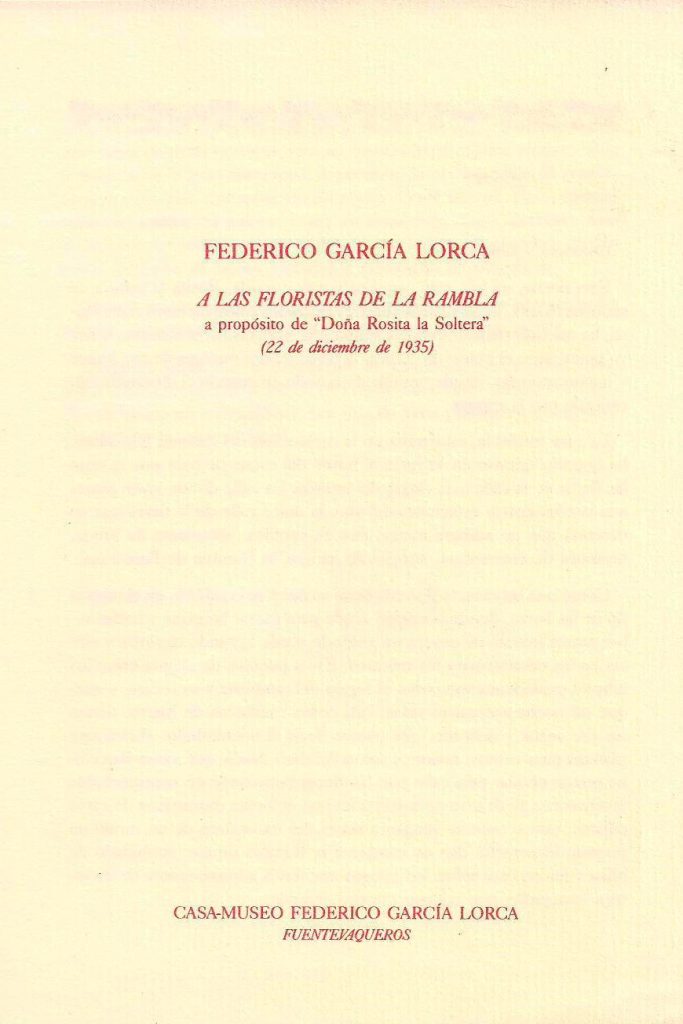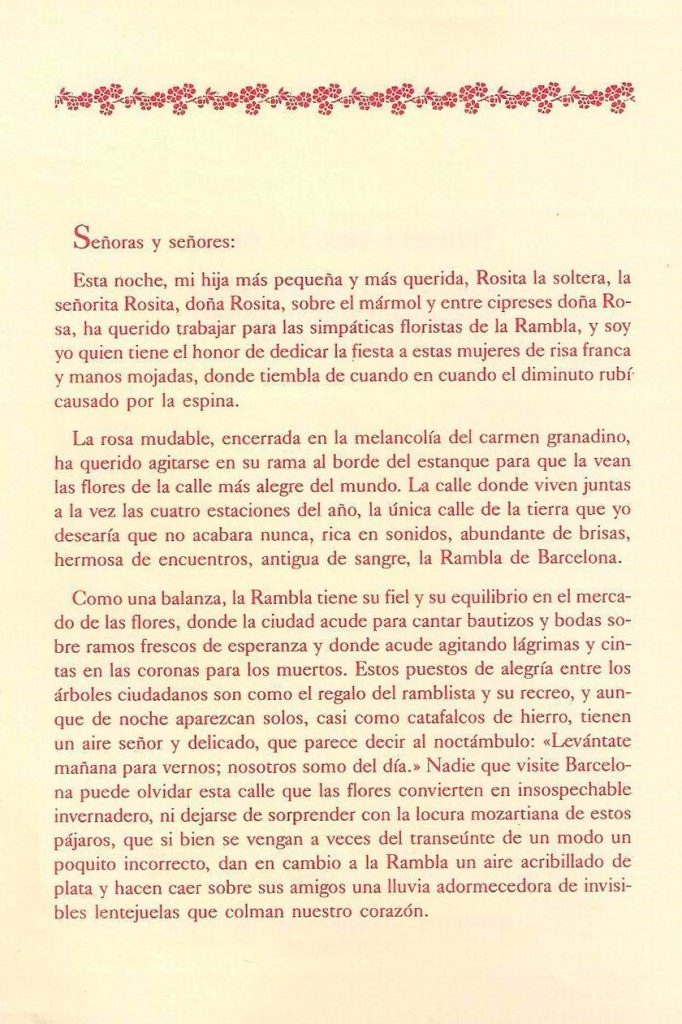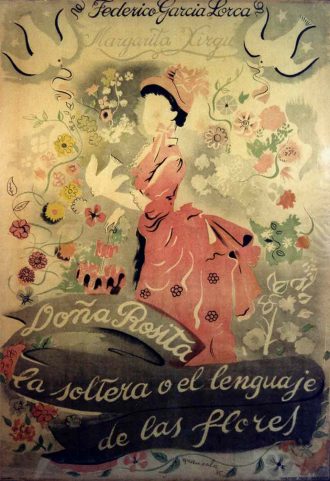
Doña Rosita the Spinster (Doña Rosita la soltera) or The Language of Flowers. A Grandaine poem from the nineteenth century, divided into several gardens, with scenes of song and dance is structured in three acts that are set in 1890, 1900 and 1910.
In the first, we are introduced to the uncle’s fondness for growing flowers in a greenhouse, as well as the character of the aunt and the mistress, who, although they are always arguing, share a love for Rosita, the niece who has grown up with them and who is already a young woman engaged to her cousin. Taking advantage of Rosita’s departure, the nephew (Rosita’s fiancé) comes to announce to his aunt that he is leaving for Tucumán where his father is. Despite the separation, the cousin promises her that he will marry her again, and she promised that she would wait for him.
In the second act, ten years later, the world has changed, but Rosita is still in the same place, embroidering her trousseau and waiting for her cousin’s letters. The aunt and the mistress argue about whether Rosita should forget her fiancé and get married. She is visited (it is her saint’s day) by the spinsters and the Ayolas, and the contempt for women who remain unmarried and the classism that exists at the time is revealed. The act ends with the arrival of a letter in which the cousin proposes to Rosita to get married by proxy. The mistress continues to show her disagreement with this situation.
In the third act, the uncle has already died and the women must leave the house in the Albaicín where they lived. Rosita’s cousin has already married another and she has been left alone, already old and deceived, after so much waiting. During this last act, they are evicting the house and in the end they abandon it to move to another one. The house had been mortgaged to pay for her trousseau. The play ends with the same metaphor that appeared in the three acts of the mutabile rose, red when the day begins, white in the middle of the day and faded and withered when the night arrives.
This was the last play Lorca premiered during his lifetime, which was staged at the Principal Palace Theater in Barcelona, on December 12, 1935, although it was originally scheduled for the 10th, but was postponed so that Lorca, who was in Madrid, had time to supervise the last rehearsals. Performers: Margarita Xirgu (Doña Rosita), Amalia Sánchez Ariño (Housekeeper), Eloísa Vigo (the aunt), Isabel Gisbert (first Manola), Isabel Pradas (second Manola), Eloísa Cañizares (third Manola), Juana Lamoneda (first spinster), Teresa Pradas (second spinster), Amelia de la Torre (third spinster), Emilia Millán (mother of the spinsters), Eloísa Cañizares (first Ayola), Antonia Calderón (second Ayola), Alejandro Maximino (the uncle), Pedro López Lagar (the nephew), Alberto Contreras (professor of Economics), José Cañizares (Mr. Martín), José Jordá (the boy) and Daniel Planas and C. Rivas Cherif (two workers). Director: Cipriano Rivas Cherif.
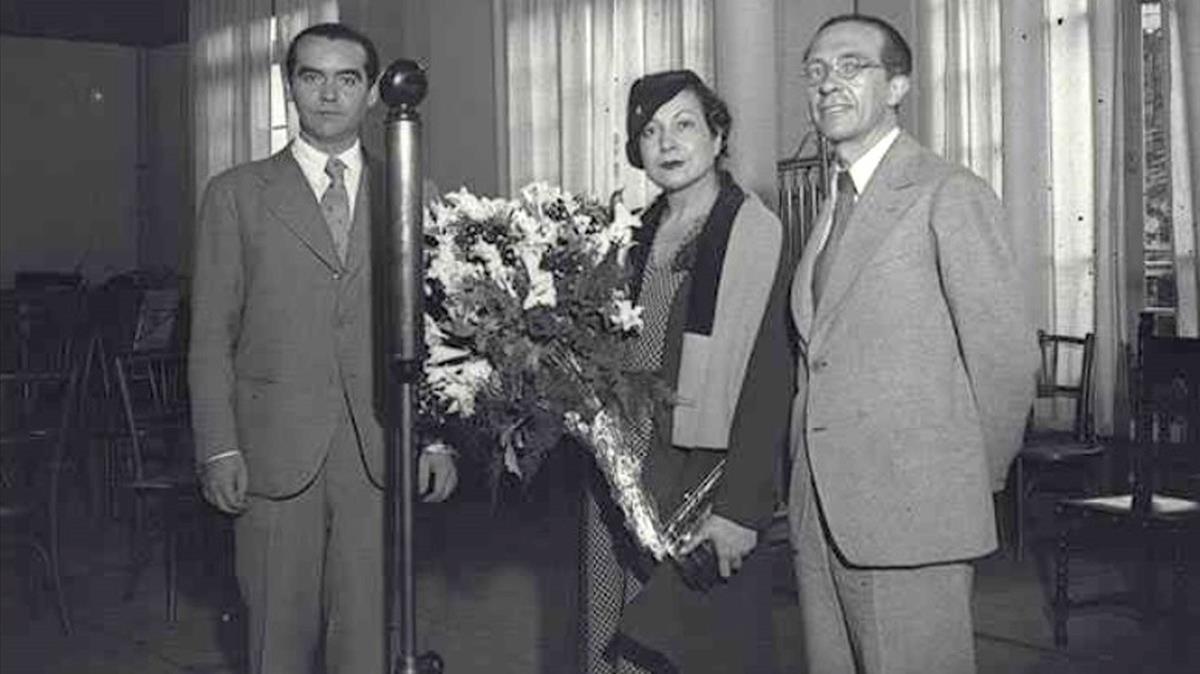
Lorca took care of the staging, from the music to the furniture, which he chose in Conrado Verdaguer’s antique shop on La Paja street. The score, written by the poet, presented Doña Rosita’s reverie to the rhythm of a waltz, highlighting the unreal and illusionary atmosphere. The sets and figurines were designed by Manuel Fontanals. The costumes, by Marbel.
Doña Rosita astonishes the audience that crowded the Principal Palace theater in Barcelona. The theater critic María Luz Morales says that it was amazing how the poet managed to make the audience laugh and cry at the same time. Lorca was surprised by her opinion and sought her out to meet her and thank her. Eduardo Haro also writes a review in La Libertad, where he says that Federico’s work proves that good theater can be performed in Spain. Lorca comments among journalists that he was going to send press copies to Granada so that the authorities would realize who he was besides being a playwright, which suggests that he did not feel very well liked, especially by those who governed the city at the time. In January 1936, the play had already been performed 47 times in the Catalan capital. It was also performed that spring in Mexico, where the poet had planned to travel to meet Margarita Xirgu.
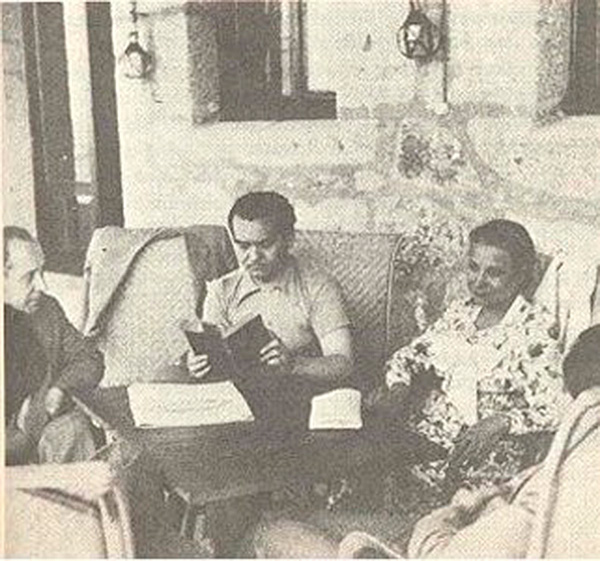
It was never performed in Madrid. It was scheduled for September, when Margarita Xirgu returned from Mexico. The poet was murdered that summer.
On May 16, 1980, under the direction of the Argentinean Jorge Lavelli, a play by Lorca was performed for the first time in Granada by a professional company after the poet was shot. Doña Rosita the spinster also remained unpublished on the stages of Granada and was the only one of Lorca’s great dramatic pieces that until this year had not been performed in Spain since 1939. The performance, at the Isabel la Católica theater in Granada, was described as a true theatrical event by the local press and days before it was sold out.
The poet situates the work in Granada, indeed, he subtitles it Poema granadino del novecientos…(Granada Poem of the Nineteenth Century) Specifically, the story is told from a typical house of the Albaicín, an ideal dwelling for the poet in Granada. He evokes in it the Alhambra, the Puerta de Elvira (Gate of Elvira), with its manolas (well-dressed women), “…las que se van a la Alhambra [those who are going to the Alhambra], / las tres y las cuatro solas…” [the three and four alone…”]. It is a criticism of the vulgar, corny and hermetic atmosphere of the Granada petty bourgeoisie of the late nineteenth and early twentieth centuries. It is, aesthetically, a romantic vision of the city. It is a reflection on the city of the past, of his childhood and, above all, of the intrahistory of his family. This work reflects like no other the poet’s complex relationship with Granada.
The sentimental knot of Doña Rosita belongs to a love story starring a cousin of the author, Clotilde García Picossi. This woman identified with the character, revealing her secret over time: her boyfriend, a first cousin, went to the Argentine Tucumán and there married another; she waited for him for a long time.
Federico was always very close to his cousin Clotilde who spent much of the year in her Huerta del Tamarit (Tamarit Farmhouse), near the Huerta de San Vicente (San Vicente Farmhouse), in the fertile plain of Granada, summer residence of the García Lorca family. Also included in this story are the memories of the times of his mother, or of other single women known to him, such as his friend Emilia Llanos.
In Doña Rosita there are other characters that emerge from reality and even appear with their own names, such as the Housekeeper, who reflects in her way of speaking and acting one of the maids of the family, Dolores Cuesta, La Colorina. Her way of expressing herself is reminiscent of Asquerosa (Disgusting), she represents natural life as opposed to the world of appearances so important at that time. Professor Martín is based on his teacher at Sagrado Corazón School in Granada, Martín Scheroff; Señor X is Ramón Guixé y Mexía; Professor Consuegra also has his correlate in reality. The characters of the manolas (women in a procession) and “ayolas” were real. The three “manolas”, besides being those of the popular song, were three inseparable girls who lived on the Gomérez slope. Father Ayala also existed, he was really a photographer for His Majesty the King, and the Ponce de León and Pérez de Herrasti families also existed.
According to Francisco García Lorca, The “language of flowers” comes from the illustrated guides on the subject, very popular at the time and which appeared alongside the “language of stamps”, the “language of fans”, etc. “With Doña Rosita the spinster or the language of flowers,” Federico declared, “I wanted to make a poem of my childhood in Granada, in which creatures and environments that I have known and felt appear.”
Margarita Xirgu, the protagonist of the play, received a bouquet of flowers every day after the first performance, without a card or name. It was a gift from the florists of Las Ramblas. The actress and the author, before that friendly and courteous gesture, dedicated an extraordinary performance to those women of “…frank laughter and wet hands, where the tiny ruby caused by the thorn trembles from time to time” and Lorca paid tribute to them with a few words.
In 1924, José Moreno Villa discovered for the poet a botany book of the nineteenth century (although Lorca would say somewhere in the eighteenth century) in which the mutable rose was described. A singular rose that is red when it opens, intensifies its color in full bloom and becomes pale when it begins to wither, until it turns white.
From Lorca we know that, when Moreno Villa finished telling him “…the marvelous tale of the rose”, he had already completed his comedy. “It appeared to me”, he says, “finished, unique, impossible to reform”. However, he would not write it until ten years later, although there are many texts that anticipate it throughout these years.
Lorca’s topic arose from the image of the three stages of the ephemeral life of the rose. The poet saw in the story of the mutable rose, as he called it, the dark drama of the spinsterhood of Spanish girls sacrificed by society and condemned to a stupid virginity.
There are no traces of the original manuscript. The most important modern editions will be those of Guillermo de Torre, in Losada, in 1938 (which follows an actor’s copy of the company of Margarita Xirgu), that of Arturo del Hoyo in Aguilar, in 1954, and of Luis Martínez Caritiño in Espasa-Calpe, in the Austral collection, in 1992.
